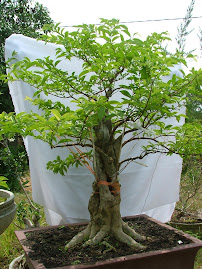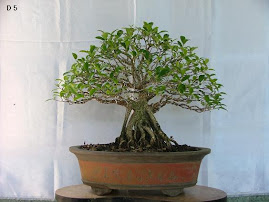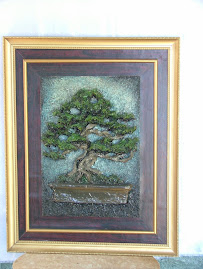Keindahan bonsai tak lepas dari syarat dasar tanamannya. Syarat dasar tanaman bonsai adalah memiliki batang yang keras dan berumur panjang untuk proses pembentukan. Bambang Hermanto dari Juanda Bonsai berbagi pengalaman tentang syarat dasar tanaman bonsai yang baik.
Ada beberapa favorit jenis tanaman yang biasa digunakan oleh pebonsai sebagai syarat dasar tanaman bonsai. Diantaranya adalah jeruk kikit, asem jawa, beringin, dan sentigi. Dari beberapa jenis yang digunakan, sentigi mempunyai daya tahan lebih baik untuk proses pembentukan bonsai dibandingkan jenis lainnya. Pasalnya, asal tumbuhan keras ini ada di pesisir pantai dengan kondisi yang ekstrim.
Faktor daya tahan yang dimiliki jenis sentigi inilah, maka sentigi sering jadi pilihan penghobi, kolektor, dan pembibit. Ini dikatakan Bambang Hermanto, pemilik Juanda Bonsai di Surabaya, yang lebih menyukai tanaman sentigi untuk dikerjakan menjadi bonsai. Ia memilih sentigi sejak tahun 1987. Setelah merasa cocok dan berhasil mengembangkan bonsai dari sentigi, ia pun tak bisa ke lain hati. “Sentigi punya daya tahan yang baik dan gerakan yang bagus. Jadi, cocok dengan karakter saya,” imbuh Bambang.
Dilihat dari asal tanaman ini, memang bisa dipastikan kalau sentigi bisa hidup dalam iklim apapun, baik panas maupun dingin. Apalagi untuk kondisi daerah yang panas, terutama di kota besar seperti Surabaya dan Jakarta. Selain mudah dalam perawatan, sentigi juga mempunyai pola gerakan yang bagus, tertutama dari kelenturan batang dan karakter daun yang kecil. Potensi dasar yang sudah dimiliki sangat memudahkan para pebonsai untuk melakukan pengerjaan sesuai dengan keinginan mereka. Dengan mengambil pilihan untuk bonsai sentigi, Bambang mengaku hasil yang didapatkan tidak lagi konvensional. Salah satunya di tunjukkan dari koleksi sentigi bunjin gascado atau dalam bahasa Indonesia diterjemahkan sebagai gerakan tarian ke atas dan terjun ke bawah.
Dari koleksi tersebut terlihat bahwa karakter batang, dahan, dan ranting yang memanjang diolah, sehingga terlihat pohon sedang menari. Kemudian di salah satu dahan ada yang mengarah ke bawah dengan gerakan melingkar, sehingga disebut terjun.
Koleksi lainnya yang diperkenalkan adalah bunjin slanting yang berarti tarian yang condong. Nama tersebut cocok, sebab dari karakter tarian yang khas diperkuat dengan munculnya dahan besar yang condong ke luar dari pot dan meliuk ke atas kembali lagi ke pusat. Dari beberapa koleksi yang dimiliki, terlihat bahwa pria yang baru mendapatkan putra keduanya awal Agustus ini menyukai gerakan tarian dalam pengolahan bonsainya. Selain itu juga didukung oleh jenis sentigi yang memperkuat karakter bonsai miliknya.
Menurut Bambang, aliran di dunia bonsai sendiri terdiri dari beberapa karakter, tapi biasanya dipisahkan sebagai konvensional dan non konvensional. Untuk aliran konvensional biasanya menggunakan pohon beringin dengan bentuk mirip payung.
Sedangkan untuk non konvensional akan mengambil beberapa teknik gerakan baru seperti tarian maupun patahan. “Semua teknik sebenarnya sama saja, asalkan hasil akhirnya proporsional dan bisa menimbulkan perasaan teduh bagi yang melihat,” tandasnya.
Perawatan Mudah
Sentigi berasal dari beberapa daerah kepulauan yang tersebar di hampir seluruh Indonesia dan beberapa kepulauan tropis di dunia, seperti Sulawesi Selatan dan negara Afrika. Dengan habitat awal yang berada di wilayah pesisir, menjadikannya sebagai tanaman yang bisa tumbuh dimana saja, meski dengan perawatan dan perlakuan biasa.
Wajar apabila perawatan yang dilakukan tidak terlalu sulit, asalkan terpenuhi tiga unsur penting, yaitu air, angin, dan panas yang kuat. Ketiga unsur tersebut mutlak dipenuhi untuk mendapatkan pertumbuhan yang maksimal. Bahkan, masih kata Bambang, sentigi bisa bertahan dengan siraman air yang mengandung unsur garam lebih.
Itu bisa kita lihat di lokasi nurseri miliknya di kota Surabaya, dimana air tanahnya sedikit asin. Selain itu udara yang ada, banyak mengandung polusi dari banyaknya kendaraan yang melintas di dekat nurserinya. Namun itu menjadikan satu keuntungan tersendiri. “Sinar matahari dan hembusan angin yang kuat dibutuhkan oleh sentigi,” kata Bambang singkat.
Untuk media tanam yang digunakan cukup sederhana, yaitu dengan komposisi dominasi pasir Malang dan pupuk kandang. Pemilihan pasir memang sengaja diambil, karena dilihat dari habitat asli tanaman ini yang berada di pesisir pantai, sehingga kandungan pasirnya cukup besar.
Secara rutin media tanam harus disiram dan dijaga agar tetap basah. Ini dilakukan untuk menghindari tanaman kekurangan air. Yang perlu diingat adalah sinar matahari mutlak diperlukan, sehingga disarankan untuk meletakkan tanaman ini di luar ruangan.
Penyakit jadi satu hal yang ditakutkan oleh penghobi tanaman hias, termasuk bonsai sentigi. Hama utama yang sering menyerang adalah kutu merah dan ulat yang bisa menghabiskan daun serta menyerang batang. Pada tingkat berat, bonsai yang Anda miliki bisa saja mati.
Langkah awal yang dilakukan bila bonsai Anda terkena hama antara lain memisahkan bonsai dengan koleksi lainnya. Ini dilakukan untuk menghindari penularan. Bila hanya satu atau dua tanaman yang terserang sebaiknya dilakukan pembersihan tanpa bahan kimia. Caranya, tentu Anda harus melihat satu persatu bagian bonsai dan membuang kutu dan ulat.
Namun bila serangan hama sudah parah dan menyebar pada koleksi bonsai lainnya, cara terakhir tentu dengan menggunkan pestisida. Jangan lupa untuk menggunakannya sesuai dosis, sebab bila berlebih bisa menyebabkan hama tersebut kebal dan lebih sulit untuk dibasmi.
Biarkan Tumbuh Liar untuk Hasil Maksimal
Untuk pembentukan bonsai sentigi, Bambang menggunakan cara meliarkan dulu tanamannya, supaya mempermudah proses pembentukan. Dari bahan mentah bonsai yang didapat, sebaiknya dibiarkan dulu tumbuh liar untuk melihat gerakannya. Langkah ini diambil menyesuaikan karakter tanaman yang mempunyai dahan memanjang.
Setelah terlihat arah dan pembentukan bahan, selanjutnya dilakukan wiring dan purning (pemangkasan) beberapa dahan yang tidak diperlukan. Setelah pengkawatan pertama, tumbuhan diliarkan kembali supaya ketepatan proses pemotongan dan pengkawatannya terlihat.
“Kalau kita salah memotong cabang, akibatnya bisa fatal dan pengerjaannya akan lebih sulit,” ujar Bambang. “Bahkan dari beberapa bahan yang dikerjakan ada beberapa yang dijual dengan harga murah, akibat salah potong dahan. Kesalahan tersebut dilakukan saat mulai belajar, tapi sekarang sudah bisa diantisipasi,” tambahnya.
Setelah tumbuh liar dari wiring pertama, maka dilakukan purning kedua untuk dahan yang tidak dipakai. Dari proses wiring kedua, maka bonsai sudah memperlihatkan karakter dan selanjutnya perlakuan dilakukan menyesuaikan dengan pertumbuhan pohon. [wo2k]
Pasar Andalkan Komunitas
Pasar bonsai andalkan komunitasnya, sehingga ia masih laku terjual di pasar. Komunitas bonsai sendiri makin menunjukkan loyalitasnya dengan membuat wadah Perkumpulan Penggamar Bonsai Indonesia (PPBI). Kebetulan Bambang, pemilik Juanda Bonsai, ini menjabat sebagai wakil ketua PPBI Sidoarjo.
Salah satu agenda yang sedang digarap adalah merekrut sebanyak mungkin penggemar bonsai, khususnya untuk kelas pemula. Selain itu juga dilakukan pertemuan rutin sebagai ajang tukar ide dan pendidikan bagi pemula. Dengan makin banyak penggemar bonsai, otomatis pasar bursa akan mengikutinya.
Di beberapa wilayah yang dinilai memiliki sedikit penggemar bonsai, diusahakan untuk menggelar dan mengikuti pameran tanaman hias. Tujuannya untuk menunjukkan eksistensi bahwa bonsai, penggemar loyal, dan pasarnya masih ada.
“Usaha bonsai saat ini memang agak berat, sebab meski pasar ada, tapi tidak besar,” tandas Bambang.Dilihat dari kondisi saat ini, ada beberapa alternatif yang bisa dilakukan oleh pengusaha bonsai, yaitu dengan menggarap semua segmen bonsai atau melengkapi koleksinya dengan tanaman hias yang jadi tren. Misalnya anthurium jenmanii atau adenium.
Untuk menyasar semua segmen bonsai, mulai dari bakalan, setengah jadi, bonsai jadi, dan bonsai kolektor masih bisa dilakukan demi kelangsungan usaha. Namun bila menyasar segmen yang luas, diperlukan Sumber Daya Manusia (SDM) yang banyak serta jaringan yang luas.
Pasalnya, untuk bakalan bonsai jenis sentigi saat ini banyak diburu, karena menjanjikan hasil yang baik. Bahan di beberapa lokasi yang biasa digunakan oleh pemburu bakalan bonsai sudah banyak berkurang, seperti di Madura, Jember, Sulawesi, dan Sumatera. Sedangkan untuk segmen kolektor, biasanya harus mendapatkan bonsai yang sempurna, yang tidak semua orang bisa melakukannya. [wo2k]























